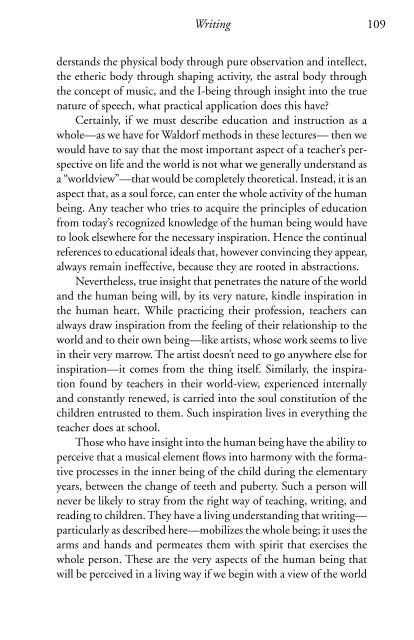Teaching Language arTs in The WaLdorf schooL
Teaching Language arTs in The WaLdorf schooL
Teaching Language arTs in The WaLdorf schooL
Create successful ePaper yourself
Turn your PDF publications into a flip-book with our unique Google optimized e-Paper software.
Writ<strong>in</strong>g<br />
109<br />
derstands the physical body through pure observation and <strong>in</strong>tellect,<br />
the etheric body through shap<strong>in</strong>g activity, the astral body through<br />
the concept of music, and the I-be<strong>in</strong>g through <strong>in</strong>sight <strong>in</strong>to the true<br />
nature of speech, what practical application does this have?<br />
Certa<strong>in</strong>ly, if we must describe education and <strong>in</strong>struction as a<br />
whole—as we have for Waldorf methods <strong>in</strong> these lectures— then we<br />
would have to say that the most important aspect of a teacher’s perspective<br />
on life and the world is not what we generally understand as<br />
a “worldview”—that would be completely theoretical. Instead, it is an<br />
aspect that, as a soul force, can enter the whole activity of the human<br />
be<strong>in</strong>g. Any teacher who tries to acquire the pr<strong>in</strong>ciples of education<br />
from today’s recognized knowledge of the human be<strong>in</strong>g would have<br />
to look elsewhere for the necessary <strong>in</strong>spiration. Hence the cont<strong>in</strong>ual<br />
references to educational ideals that, however conv<strong>in</strong>c<strong>in</strong>g they appear,<br />
always rema<strong>in</strong> <strong>in</strong>effective, because they are rooted <strong>in</strong> abstractions.<br />
Nevertheless, true <strong>in</strong>sight that penetrates the nature of the world<br />
and the human be<strong>in</strong>g will, by its very nature, k<strong>in</strong>dle <strong>in</strong>spiration <strong>in</strong><br />
the human heart. While practic<strong>in</strong>g their profession, teachers can<br />
always draw <strong>in</strong>spiration from the feel<strong>in</strong>g of their relationship to the<br />
world and to their own be<strong>in</strong>g—like artists, whose work seems to live<br />
<strong>in</strong> their very marrow. <strong>The</strong> artist doesn’t need to go anywhere else for<br />
<strong>in</strong>spiration—it comes from the th<strong>in</strong>g itself. Similarly, the <strong>in</strong>spiration<br />
found by teachers <strong>in</strong> their world-view, experienced <strong>in</strong>ternally<br />
and constantly renewed, is carried <strong>in</strong>to the soul constitution of the<br />
children entrusted to them. Such <strong>in</strong>spiration lives <strong>in</strong> everyth<strong>in</strong>g the<br />
teacher does at school.<br />
Those who have <strong>in</strong>sight <strong>in</strong>to the human be<strong>in</strong>g have the ability to<br />
perceive that a musical element flows <strong>in</strong>to harmony with the formative<br />
processes <strong>in</strong> the <strong>in</strong>ner be<strong>in</strong>g of the child dur<strong>in</strong>g the elementary<br />
years, between the change of teeth and puberty. Such a person will<br />
never be likely to stray from the right way of teach<strong>in</strong>g, writ<strong>in</strong>g, and<br />
read<strong>in</strong>g to children. <strong>The</strong>y have a liv<strong>in</strong>g understand<strong>in</strong>g that writ<strong>in</strong>g—<br />
particularly as described here—mobilizes the whole be<strong>in</strong>g; it uses the<br />
arms and hands and permeates them with spirit that exercises the<br />
whole person. <strong>The</strong>se are the very aspects of the human be<strong>in</strong>g that<br />
will be perceived <strong>in</strong> a liv<strong>in</strong>g way if we beg<strong>in</strong> with a view of the world

















